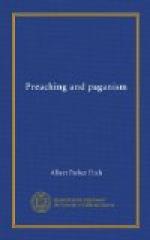So, if we deal first with worship, we are merely beginning at the beginning and starting at the bottom. And, in the light of this observation, it is appalling to survey the non-liturgical churches today and see the place that public devotion holds in them. It is not too much, I think, to speak of the collapse of worship in Protestant communities. No better evidence of this need be sought than in the nature of the present attempts to reinstate it. They have a naivete, an incongruity, that can only be explained on the assumption of their impoverished background.
This situation shows first in the heterogeneous character of our experiments. We are continually printing on our churches’ calendars what we usually call “programs,” but which are meant to be orders of worship. We are also forever changing them. There is nothing inevitable about their order; they have no intelligible, self-verifying procedure. Anthems are inserted here and there without any sense of the progression or of the psychology of worship. Glorias are sung sometimes with the congregation standing up and sometimes while they are sitting down. There is no lectionary to determine a comprehensive and orderly reading of Scripture, not much sequence of thought or progress of devotion either in the read or the extempore prayers. There is no uniformity of posture. There are two historic attitudes of reverence when men are addressing the Almighty. They are the standing upon one’s feet or the falling upon one’s knees. For the most part we neither stand nor kneel; we usually loll. Some of us compromise by bending forward to the limiting of our breath and the discomfort of our digestion. It is too little inducive to physical ease or perhaps too derogatory to our dignity to kneel before the Lord our Maker. All this seems too much like the efforts of those who have forgotten what worship really is and are trying to find for it some comfortable or attractive substitute.
Second: we show our inexperience by betraying the confusion of aesthetic and ethical values as we strive for variety and entertainment in church services; we build them around wonder and admiration, not around reverence and awe. But we are mistaken if we suppose that men chiefly desire to be pleasantly entertained or extraordinarily delighted when they go into a church. They go there because they desire to enter a Holy Presence; they want to approach One before whom they can be still and know that He is God. All “enrichments” of a service injected into it here and there, designed




